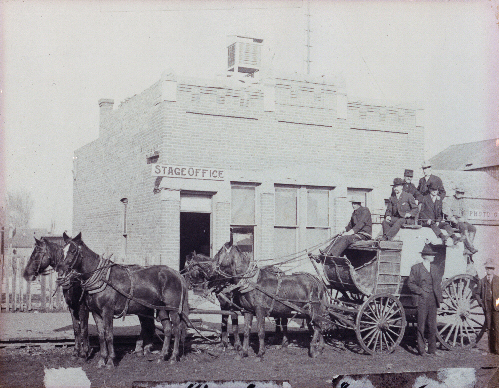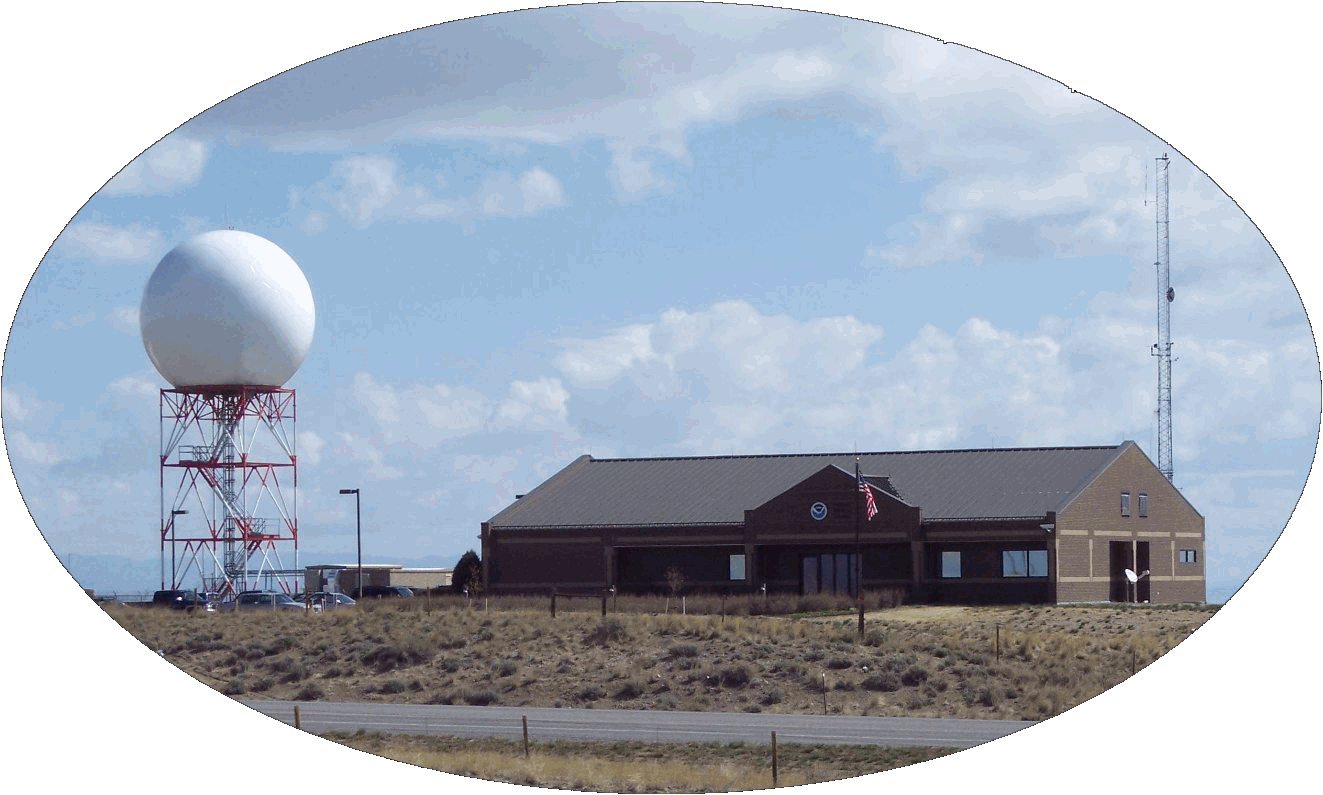The story of the National Weather Service (NWS) Weather Forecast Office (WFO) in Riverton, Wyoming actually begins in Lander, Wyoming some 23 miles to the southwest. In October 1890, President Benjamin Harrison requested Congress to create a Weather Bureau with oversight belonging to the Department of Agriculture. On August 1, 1891 the United States Weather Bureau (USWB) began recording weather observations in Lander. The station was officially established when R.M. Crawford moved records and instruments of the Army Signal Service from Fort Washakie to Lander that year.

The National Weather Service in Lander, WY (1906)
The USWB observing instrumentation was initially established on the roof of the Borland Building on the corner of Second Street and an alley between Main and Garfield streets in Lander. In the following years the office moved to the Bunce and Iiams building 36 Main Street (between 1st and 2nd streets) on December 31, 1895, and eventually to the U.S. Federal Building on March 31, 1912. The USWB office remained on the third floor (rooms 318 and 332) of the Federal Building (on the corner of 4th and Lincoln streets) for the next 34 years.
During World War II, the USWB was in need of weather observers. In 1944 and 1945 the Lander office was short-staffed and four female wartime emergency observers were brought in to help comprise a staff of 12. Hope Anderson, Irene Gehrt, Maud Ogilvie, and Dorothy Hurd worked to keep the Lander office afloat during these years taking hourly and 3-hourly observations 24 hours a day. The observations were telephoned to Rock Springs since the office did not yet have a teletype. The USWB Lander office was equipped with radiosonde capabilities beginning ion September 1, 1945 and these four women and the rest of the Lander staff launched balloons every six hours. The balloon was inflated in an unheated Forest Service garage behind the Post Office. At least one observer remembered warming her hands around an uninsulated water tank in the garage during the coldest of Wyoming weather. A starting wage during the war years was $56 every two weeks. Many of these women in later interviews expressed fond memories of their Lander experience, commenting that station morale was high and that the employees were like siblings.
The USWB Lander office moved on May 28, 1946 to the town’s local airport, Hunt Field. The office became know as a Weather Bureau Airport Station (WBAS). For the next 27 years the WBAS Lander operated in the same location at the airport until moving to newer quarters on September 20, 1973. The new Weather Service Office (WSO) remained at Hunt Field, but moved about 700 feet to its new location.

Halloween 1980 saw the arrival of the NOAA Weather Radio in Lander, a station which continues in operation today. Several new technologies arrived in the small WSO over the next decade. These new technologies included Automation of Field Operations and Services (AFOS) in the spring of 1985, which at a cost of slightly more than $10,000 replaced four aging teletype machines. Later that year the era of manual radiosonde observations ended with the arrival of the Automated Radio Theodolite (ART). The art of weather forecasting also began to change. For many years the entire state of Wyoming had been defined by 12 forecast zones, typically aligned along climatological boundaries. In April 1986, this number increased to 17 forecast zones. NWS meteorologists today produce seven-day forecasts for 50 zones statewide.
Also in 1986, the NWS announced a modernization and restructuring program designed to revamp the organizational and staffing structure of the agency. In April of that year Riverton was tentatively selected as the site for a proposed NEXRAD (Next Generation Radar) Doppler radar. The Riverton site provided advantages over a radar site at Lander, because of Lander’s location next to the mountains which hinders the effectiveness of the radar. (It is difficult to pass radar beams through granite!) At the time of the announcement no specific information was provided about where an accompanying WFO would be located. That changed in March 1988 when it was announced that Riverton would be the site for both the radar and the WFO on a 10-acre parcel of land donated by the city of Riverton. This was formally finalized in March 1989.
Production on the 5,366 square foot Riverton WFO began with a ceremonial ground-breaking on June 24, 1994. Construction on the facility continued during the 1994-95 winter and was completed in March 1995. The installation of the radar soon followed in June and July, but not before congressional budget actions threatened the future of the operation. In May 1995, it was announced by the Department of Commerce, the cabinet-level agency under which the NWS has operated since 1940, that due to U.S. House budget actions the Riverton office and 19 other unfinished sites would be discontinued. However, this action ne
ver came to pass as the U.S. House voted in early July 1995 to include the necessary funding to complete these 20 sites. With funding in place, WFO operations began in Riverton on August 28, 1995 with a staff of 18. The radar was formally accepted on April 10, 1996 about the same time WSO Casper, which had previously issued warnings for some of central Wyoming, closed down. The building was formally dedicated during a ceremony on June 15, 1996 with Wyoming Governor Jim Geringer the Keynote Speaker.
Beginning in 1996 the Riverton WFO took warning responsibility for eleven counties in western and central Wyoming comprising over 56,000 square miles. These counties remain the same today and include Big Horn, Fremont, Hot Springs, Johnson, Lincoln, Natrona, Park, Sublette, Sweetwater, Teton, and Washakie. While the radar helped to provide enhanced warning services to these locations the complete technological infusion had yet to occur. However, the arrival of the Advanced Weather Interactive Processing System (AWIPS) in April 1999 dramatically altered the computer capabilities of the WFO. AWIPS remains the main computer interface for WFO meteorologists, but upgrades to the operating system and accompanying software occur frequently to keep up with changing technologies. The arrival of the AWIPS also ushered in five new lead forecasters to serve at the WFO. This brought the level of staffing to 23, where it remains today.
The era of typed forecasts came to an end in October, 2002 with the first issuance of a digital database of weather information. Today, the Graphical Forecast Editor (GFE) is used to create a suite of digital weather elements which in turn generate various types of forecasts for users across western and central Wyoming, most commonly the seven-day public forecast and fire weather forecast. Between October 2002 and September 2006 the WFO also oversaw the installation of 10 NOAA Weather and All Hazards radio transmitters, raising to 14 the total number of transmitters serving the 11 counties. A new radiosonde system arrived in September 2006 which utilizes the Global Positioning System (GPS) to track the sonde during its ascent – a far cry from the manual observations of 60 years previous.
Today, the 23 professionals at the Riverton WFO remain dedicated to providing the best possible weather forecasts, warnings, hydrologic, and climate information available to the citizens of western and central Wyoming. In addition to day-to-day weather forecasting, the employees maintain and repair weather observing systems across the service area, create and install new computer software, conduct scientific research, and routinely interface with customers and the public. We encourage you to stop by and visit us on U.S. Highway 26 about five miles west of Riverton.

Current NWS Office in Riverton, WY
The following individuals have been in charge of the Lander/Riverton Weather Forecast Office since its inception:
R.M. Crawford - July 1, 1891 to March 4, 1894
George W. Scott - March 4, 1894 to January 10, 1910
F.W. Wescott - January 10, 1910 to January 24, 1910
E.M. Groves - January 24, 1910 to February 3, 1911
Milton W. Dow - February 3, 1911 to June 26, 1911
R.W. Smith - June 26, 1911 to September 30, 1911
McLinn S. Collon - September 30, 1911 to May 7, 1928
Hugh D. Spangler - May 7, 1928 to March 6, 1937
Norbert G. Ribble - March 6, 1937 to July 10, 1946
Byron A. Young - July 10, 1946 to October 2, 1948
Ivin L. Gee - November 19, 1948 to December 10, 1974
George Crabtree - March 1975 to November 1979
Jerry A. Leslie - March 1980 to August 1994
Valeria Capell - August 1995 to April 2001
Joseph B. Sullivan - August 2001 to September 2006
Kevin P. Lynott - February 2007 to Present